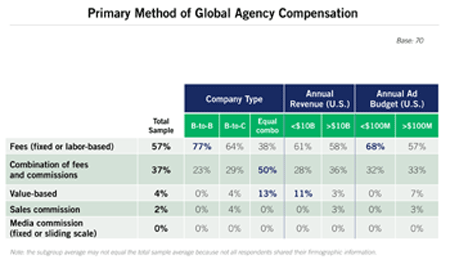New Findings on Global Marketer/Agency Compensation Practices: Study
New information has revealed how global marketers structure and manage compensation practices with their advertising agency partners in a new benchmarking study from Association of National Advertisers.
Overall, fees were found to be the dominant method of agency compensation globally practiced by 57% of respondents. An additional 37% of respondents require fees in combination with commissions. Although many marketers use traditional media commissions in combination with fees, no respondents to this survey indicated that they use only traditional commissions to compensate their global agencies. New methods of compensation, like value-based remuneration, have not taken hold globally. Only 4% reported utilizing them.
In a sign that ever more emphasis is placed on metrics and results, half of the respondents reported employing performance-based incentives (46% in the U.S. compared with 49% globally).
The differences
Despite many of the findings mirroring U.S. practices, important differences came to light.
Far more global marketers employ a combination of fees and commissions than in the U.S. (37% vs. 6%). Two factors contribute to this finding according to David Beals, president and chief executive officer of R3:JLB, who worked with the ANA and analyzed the results of the survey:
1. In markets like Japan and Brazil, commissions are still the dominant compensation practice.
2. In smaller markets, where client-marketing investments are less predictable, marketing spending does not easily allow for ongoing retainer-based compensation.
Interestingly, global marketers are considerably more likely to base incentive criteria on metrics such as media delivery, brand perception, digital delivery and copy testing, and far less likely than in the U.S. to employ sales metrics as a success criterion, the study found.
“Global marketers will now be better able to understand how their peers are wrestling with the challenges of compensating agencies across diverse countries, cultures and conditions ” Bob Liodice, president and CEO of ANA, said in the release.
(click to enlarge image)
Management models
In negotiating, overseeing and tracking agency compensation, global marketers in the survey noted a spectrum of management models, from centrally-managed at corporate headquarters, to regionally-managed by divisions, to locally-managed at the individual country level. Only a quarter (24%) manage their global agency compensation via a central, headquarters-driven approach.
About half (48%) employ a combination approach—involving central, regional and local operational resources—to manage their global agency compensation.
In addition, 75% of global respondents reported that corporate procurement departments are significantly involved in the management and negotiation of agency compensation. Of this number:
47% say the process is procurement-led with marketing support
28% say the process is marketing-led with procurement support
“While many global marketers may establish their approach to agency compensation at corporate headquarters, most need to rely on their regional and local operations, in combination with their procurement colleagues, to effectively address significant differences in local costs, practices, laws and cultures,” Beals said.
A number of open-ended questions provided the following four insights:
1. Gaining alignment on goals, strategies and approaches, both within the client’s organization and between the client and agency global operations
2. Effectively addressing the needs of both the global organization and its local operations
3. Dealing with country-by-country differences in compensation rates, languages, cultures, laws and practices, as well as with the “I know what is best” local mindset within client organizations
4. Structuring and managing performance incentive compensation arrangements that address both global and local region / country goals and needs
Methodology This ANA Global Agency Compensation Study was fielded online in February and March of 2012. In total, 71 client-side marketers participated from global marketing organizations including Brown-Forman, Dell, Ford, IBM, Intel, Johnson & Johnson and Merck. Marketers operating in nearly 40 countries across all continents were polled.


























